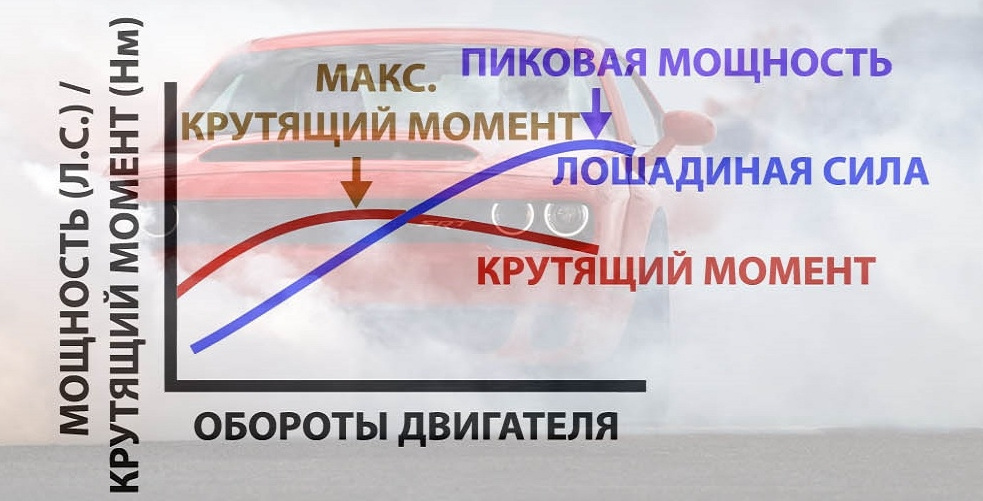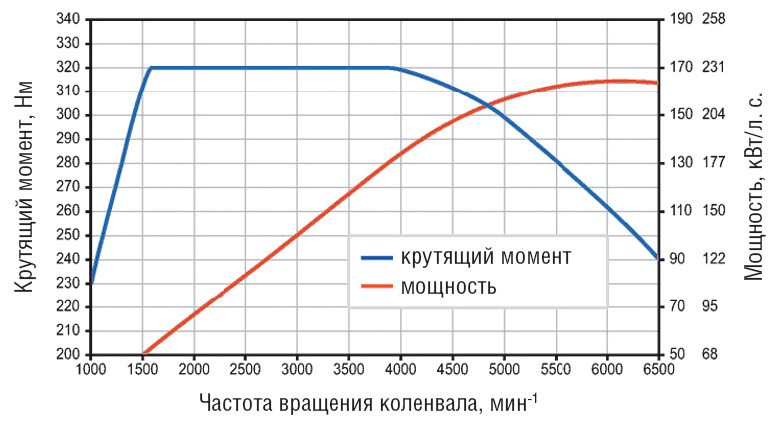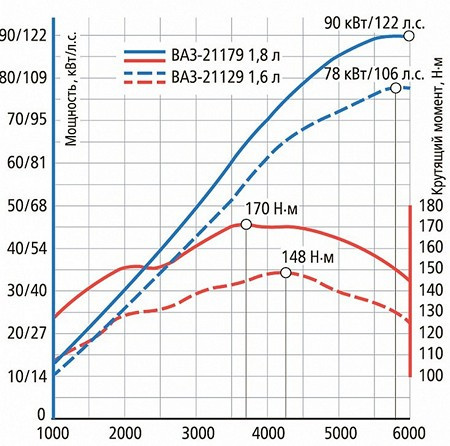
Engine torque
Content
- The concept of the torque of the internal combustion engine. Complex in simple words
- Factors affecting the magnitude of the torques
- Influence of ICE torque on vehicle performance
- Torque vs power. Relationship with vehicle dynamics
- Diesel moment
- Features of the correct acceleration of the car. How to get the most out of your car
- Engine selection. Which is better - high torque or increased power?
Speaking about the most important automotive unit: the engine, it has become customary to exalt power above other parameters. Meanwhile, it is not power capacities that are the main characteristics of a power plant, but a phenomenon called torque. The potential of any automobile engine is directly determined by this value.

The concept of the torque of the internal combustion engine. Complex in simple words
Torque in relation to automobile engines is the product of the magnitude of the effort and the lever arm, or, more simply, the pressure force of the piston on the connecting rod. This force is measured in Newton meters, and the higher its value, the faster the car will be.
In addition, engine power, expressed in watts, is nothing more than the value of engine torque in Newton meters multiplied by the speed of rotation of the crankshaft.
Imagine a horse pulling a heavy sled and getting stuck in a ditch. Pulling the sled will not work if the horse tries to jump out of the ditch on the run. Here it is necessary to apply a certain effort, which will be the torque (km).
Torque is often confused with crankshaft speed. In fact, these are two completely different concepts. Returning to the example of the horse stuck in the ditch, the stride frequency would represent the speed of the motor, and the force exerted by the animal as it moved during the stride would in this case represent the torque.
Factors affecting the magnitude of the torques
On the example of a horse, it is easy to guess that in this case the value of SM will be largely determined by the muscle mass of the animal. With regard to the internal combustion engine of a car, this value depends on the amount of work of the power plant, as well as on:
- the level of working pressure inside the cylinders;
- piston size;
- crankshaft diameter.
Torque is most strongly dependent on the displacement and pressure inside the power plant, and this dependence is directly proportional. In other words, motors with high volume and pressure, respectively, have a large torque.
There is also a direct relationship between the KM and the crank radius of the crankshaft. However, the design of modern automobile engines is such that it does not allow torque values to vary widely, so ICE designers have little opportunity to achieve higher torque due to the curvature of the crankshaft. Instead, developers are turning to ways to increase torque, such as using turbocharging technologies, increasing compression ratios, optimizing the combustion process, using specially designed intake manifolds, etc.
It is important that the KM increases with increasing engine speed, however, after reaching a maximum in a given range, the torque decreases, despite a continuous increase in the crankshaft speed.

Influence of ICE torque on vehicle performance
The amount of torque is the very factor that directly sets the dynamics of acceleration of the car. If you are an avid car enthusiast, you might have noticed that different cars, but with the same power unit, behave differently on the road. Or an order of magnitude less powerful car on the road is superior to one with more horsepower under the hood, even with comparable car sizes and weights. The reason lies precisely in the difference in torque.
Horsepower can be thought of as a measure of the endurance of an engine. It is this indicator that determines the speed capabilities of the car. But since torque is a kind of force, it depends on its magnitude, and not on the number of "horses", how quickly the car can reach the maximum speed limit. For this reason, not all powerful cars have good acceleration dynamics, and those that can accelerate faster than others are not necessarily equipped with a powerful engine.
However, high torque alone does not guarantee excellent machine dynamics. After all, among other things, the dynamics of the increase in speed, as well as the ability of the car to quickly overcome the slopes of the sections depend on the operating range of the power plant, transmission ratios and responsiveness of the accelerator. Along with this, it should be noted that the moment is significantly reduced due to a number of counteracting phenomena: the rolling forces of the wheels and friction in various parts of the car, due to aerodynamics and other phenomena.
Torque vs power. Relationship with vehicle dynamics
Power is a derivative of such a phenomenon as torque, it expresses the work of the power plant performed at a given time. And since the KM personifies the direct operation of the engine, the magnitude of the moment in the corresponding period of time is reflected in the form of power.
The following formula allows you to visually see the relationship between power and KM:
P=M*N/9549
Where: P in the formula is power, M is torque, N is engine rpm, and 9549 is the conversion factor for N to radians per second. The result of calculations using this formula will be a number in kilowatts. When you need to convert the result into horsepower, the resulting number is multiplied by 1,36.
Basically, torque is power at partial speeds, such as overtaking. Power increases as torque increases, and the higher this parameter, the more kinetic energy, the easier the car overcomes the forces acting on it, and the better its dynamic characteristics.
It is important to remember that the power reaches its maximum values not immediately, but gradually. After all, the car starts at a minimum speed, and then the speed increases. This is where the force called torque comes in, and it is this that determines the period of time during which the car will reach its maximum power, or, in other words, high-speed dynamics.

It follows from this that a car with a more powerful power unit, but not enough high torque, will be inferior in acceleration to a model with an engine that, on the contrary, cannot boast of good power, but surpasses a competitor in a pair. The greater the thrust, the force is transmitted to the drive wheels, and the richer the speed range of the power plant, in which a high KM is achieved, the faster the car accelerates.
At the same time, the existence of torque is possible without power, but the existence of power without torque is not. Imagine that our horse and sleigh are stuck in the mud. The power produced by the horse at this moment will be zero, but the torque (trying to get out, pulling), although not enough to move, will be present.
Diesel moment
If we compare gasoline power plants with diesel ones, then the distinguishing feature of the latter (all without exception) is higher torque with less power.
A gasoline internal combustion engine reaches its maximum KM values at three to four thousand revolutions per minute, but then is able to quickly increase power, making seven to eight thousand revolutions per minute. The range of revolutions of the crankshaft of a diesel engine is usually limited to three to five thousand. However, in diesel units, the piston stroke is longer, the compression ratio and other specific characteristics of fuel combustion are higher, which provides not only more torque relative to gasoline units, but also the presence of this effort almost from idle.
For this reason, it makes no sense to achieve increased power from diesel engines - reliable and affordable traction "from below", high efficiency and fuel efficiency completely level the gap between such internal combustion engines and gasoline engines, both in terms of power indicators and speed potential.
Features of the correct acceleration of the car. How to get the most out of your car
Proper acceleration is based on the ability to work with the gearbox and follow the principle of “from maximum torque to maximum power”. That is, it is possible to achieve the best car acceleration dynamics only by keeping the crankshaft speed in the range of values at which the KM reaches its maximum. It is very important that the speed coincides with the peak torque, but there must be a margin for its increase. If you accelerate to speeds above the maximum power, the acceleration dynamics will be less.
The rpm range corresponding to the maximum torque is determined by the characteristics of the engine.
Engine selection. Which is better - high torque or increased power?
If we draw the last line under all of the above, it becomes obvious that:
- torque is a key factor characterizing the capabilities of the power plant;
- power is a derivative of KM and therefore a secondary characteristic of the engine;
- a direct dependence of power on torque can be seen in the formula P (power) \uXNUMXd M (torque) * n (crankshaft speed per minute) derived by physicists.
Thus, when choosing between an engine with more power, but less torque, and an engine with more KM, but less power, the second option will prevail. Only such an engine will allow you to use the full potential inherent in the car.
At the same time, we must not forget about the relationship between the dynamic characteristics of the car and factors such as throttle response and transmission. The best option would be one that not only has a high-torque motor, but also the smallest delay between pressing the gas pedal and engine response, and a transmission with short gear ratios. The presence of these features compensates for the low power of the engine, causing the car to accelerate faster than a car with an engine of similar design, but with less traction.